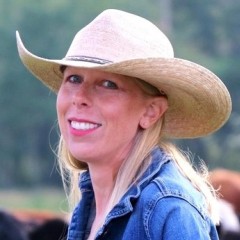Most people don’t associate mechanical engineering with cattle grazing — unless they know Mark Burggren.
Although he spent summers on his grandfather’s Strathmore-area ranch in his younger days, Burggren knew little about cattle until retiring as a mechanical engineer in 2007 and buying a quarter section near Condor. But he’s getting nearly 50 per cent more productivity from his grass than the average conventional producer.

This past fall, Burggren asked the neighbour, who puts cattle on his land, if his controlled grazing strategies were really paying off and if the rancher saw any difference in productivity between his quarter and other quarters the cattle owner grazes.
“He said, ‘Good heavens yes, Mark. I doubt there is another quarter in the region that earns as much as you do because I can put more cattle on your place and leave them for longer than anywhere else I rent,’” recalled Burggren. “‘For the last two years, we’ve had 46 pairs and a bull with you, while the most I can put on any other quarter I rent is 35 pairs plus a bull.’”
Burggren is quick to give credit to others: He said he got a “leg up” because the cow-calf producer who sold him the quarter was already practising controlled grazing using paddocks laid out on a hub-and-spoke concept. He found the system intriguing and wanted to know more.
Read Also

Farming Smarter receives financial boost from Alberta government for potato research
Farming Smarter near Lethbridge got a boost to its research equipment, thanks to the Alberta government’s increase in funding for research associations.
“I joined the Grey Wooded Forage Association early in the game and I started reading the Stockman Grass Farmer,” he said. “I kind of got enthralled with this idea of replicating the way that grass genetically was developed over eons by having the great herds of the earth pass over them, impact them pretty heavily, and then move on.”
Burggren started by taking his hand-held GPS unit and mapping the fencelines on the quarter section to get a sense of where all the existing fences were. Knowing the key to the whole equation is the rest period between grazing, he also quickly spotted a problem with the setup he had inherited.
“I noticed in some of the paddocks that they were pretty bare close to the distributor pen and water pen. In the far-back reaches, the cows never got there and it was like jungle country back there.”

He consulted Albert Kuipers, the forage and grazing specialist with the Grey Wooded Forage Association, and concluded that after the cows came up for water, they would stop and graze the young shoots of grass. That overgrazing caused the bare patches, and also meant grass in the back of the paddocks matured to the point the cows no longer fancied it.
Ever the engineer — he specialized in manufacturing management — Burggren came up with a plan. He bought some step-in fence posts, electric wire, and electric charger and created alleyways to the water pen. He also broke up 25-acre paddocks into three- to four-acre ones — 28 in all.
“I connected with a farmer down the road who has about 400 head of cattle and he is always looking for pasture,” he said. “I get his cows and calves and a bull.”
He started with 35 pairs, upped that to 46 pairs, and is aiming for 50 pairs this year. He spends 30 minutes to an hour a day on his quad checking cows and every two or three days, leads them to a new paddock.
“It’s really amazing how fast they become trained — it’s really fun,” said Burggren. “After about a week when I go out a start my quad, they can be on the other side of the quarter and their heads come up and they start trotting (towards me) because they know they are going to fresh grass.”
Last year, the cows came on May 29, a week or so early, and it was so dry Burggren moved them daily until the rains came in mid-June. The paddocks have two or three passes made on them, but are always given a good rest. For example, one three-acre paddock supported the 46 pair of cattle for six days — two days in the third week of June and then, after 72 days of rest, another four days beginning Sept. 5.
Burggren records grazing days on a spreadsheet.
“I track which paddock they are in, how many days, and so on. I use it to calculate the efficiency of each particular paddock. The way I have my spreadsheet laid out, I get an actual visual of the moves of the cattle through the individual paddocks.”
He writes the same info on a map of all his paddocks.
“This is another visual that I can use — that’s part of my engineering background,” he joked.
But that level of detail means he knows exactly how many grazing days he gets from his grass. Last year, it was 7,210 animal unit days versus 4,868 animal unit days on a conventional quarter — a hefty 48 per cent increase in productivity.
And, as his neighbour pointed out, that was in a year where drought was the story until mid-June.
“Remember,” the rancher told Burggren, “I brought the cattle to you a week before anybody else and took them off a week and a half later because you still had the grass for them.”
















